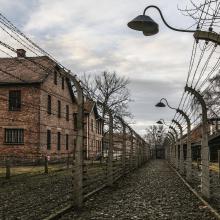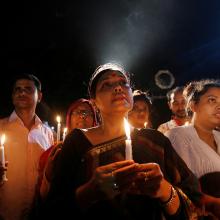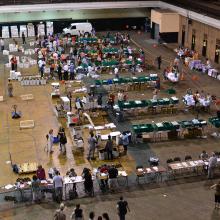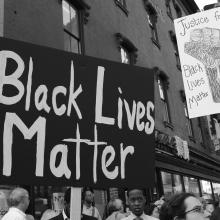Interfaith
The Quran teaches that “verily with hardship, there is relief.” I have found relief in community with Muslim sisters and brothers, with whom I share common virtues and a common future. I love them not despite of my faith, but because of it. After all, Jesus was a Palestinian refugee who loved his neighbors, even those who did not share his Jewish faith. As a Christian, I have no choice but to do the same.
New Army regulations will allow soldiers to wear turbans, beards and hijabs under most circumstances, reflecting a change Sikhs have sought for years.
“Based on the successful examples of Soldiers currently serving with these accommodations, I have determined that brigade-level commanders may approve requests for these accommodations,” wrote Secretary of the Army Eric K. Fanning in a Tuesday (Jan. 3) memo.
In March, the Army concluded that permitting beards for medical reasons but banning them for religious reasons is a discriminatory bar to service for Sikhs, who are forbidden by their faith to cut their hair and beards.
Imagine receiving this message on your voicemail: “Dear Mr. Gonzalez, we regret to inform you that your heart surgery has been canceled. The medical professionals scheduled to perform it, Doctors Sarna and Latif, have discovered that they have serious disagreements about Middle East politics. Consequently, they are refusing to work together. We will do our best to find you other doctors, before your condition becomes fatal.”
Seem far-fetched? In my mind, it is the logical outcome of the manner in which many Jewish and Muslim groups have chosen to engage each other in recent years. Or, rather, not engage.
Pwint Phyu Latt is a Muslim peace activist in Burma who sought to promote interfaith relations with Buddhists, the nation’s religious majority. She was sentenced this year to two years in prison and two more years of hard labor.
Gulmira Imin is a Uighur Muslim in China who led the 2009 Uighur protests against its communist government. She has been in prison ever since.
Normand stood outside the mosque for several hours, his message of support and solidarity offering a striking counter to the more than 800 incidents of harrassment and hate crimes that have reportedly occured since Election Day.
“WE CAN'T PUT cheese on all of the hamburgers for dinner, and can you please say ‘Dear God’ not ‘Dear Jesus’ when you pray?” These were instructions I gave to my dad before a birthday party in elementary school, worried that my new Jewish friends would not feel comfortable in our Christian home. Because I grew up in a religiously diverse area, I was cognizant of differences in religious practice before I knew the beliefs behind my own Christian rituals.
This is how my journey of interfaith learning and leadership began: by inviting my friends from school over to play and making sure they had something to eat. In his book Interfaith Leadership, Eboo Patel defines interfaith experiences as those “where people with diverse faiths interact, and their faith identities are somehow involved.” We weren’t just religiously diverse students sitting next to each other at school sharing our crayons—we were in each other’s homes, and that meant our faith identities were exposed and explored.
Interfaith Leadership outlines three questions that come up in interactions with people different from you: Who am I? Who are you? How do we relate to each other? Through stories of his experiences and those of friends from different faiths, Patel, founder of Interfaith Youth Core and a Sojourners columnist, shows us the process of becoming an interfaith leader who builds bridges and strengthens communities. He explains theories behind interfaith work in a way that is easy to understand, applying them directly to daily interactions and conflicts. For a short primer, Interfaith Leadership could be the most helpful tool for anyone striving to develop “positive, constructive, warm, caring, cooperative engagement” (aka “relationship”) with others.

Auschwitz. Image via BeeZeePhoto / Shutterstock.com
Siavosh Derakhti, a young Swedish Muslim honored in Europe and the U.S. for his campaign to counter anti-Semitism, always explains his motivation by invoking David.

Franklin Graham. Image via Paul Sherar / RNS
Pope Francis is once again making headlines for comments declaring, as he has before, that Islam is not “terroristic” and that all religions, including Catholicism, have “fundamentalist” splinter groups that can commit violence.
The pontiff made his comments during a flight back to Rome on July 31 from Poland, where he was presiding over the church’s triennial World Youth Day festival.

Image via REUTERS/Adnan Abidi/RNS
A vortex of hatred is sweeping across the globe, from a nightclub in Orlando to an airport in Istanbul to a restaurant in Dhaka.
At its center are individuals who wrap their savagery in the cloak of Islam. But these terrorists — perhaps 50,000 to 100,000 of the world’s 1.6 billion Muslims — are a perversion of the faith. They do not represent the Islam beloved by moderates like me.

Noah Leavitt and Talia Kim-Leavitt with their kids Ari and Talia. Image via Kim-Leavitt family / RNS
Noah Leavitt and Helen Kiyong Kim’s marriage is one of an increasing number of Jewish-Asian pairings in the U.S., a trend evident in many American synagogues. The two Whitman College professors have just released the first book-length study of Jewish-Asian couples and their offspring.
Though JewAsian is geared toward social scientists, the chapters in which they excerpt and analyze their interviews with 34 Jewish-Asian couples will interest any readers curious about intermarriage in general, and the evolving American-Jewish community in particular.

Image via Michele Chabin / RNS
Stuart Levy, a nurse at a Jerusalem hospital, updates his ward’s work schedule several times a week, with staffers’ vacations, birthdays and more religious holidays than many people know exist.
“We have 18 hospital beds, and on any given day we may have an Orthodox Jew next to a devout Muslim next to a Catholic next to a Druze next to a Russian Orthodox patient,” said Levy, head nurse of the oncology/hematology ward at Hadassah Medical Center-Ein Kerem. “And many of our staff are religiously observant.”

Image via Brian McDonnell / Heart to Heart International / RNS
The call went out for 600 volunteers to make care packages for Syrian refugees. Nearly 1,000 Muslims, Sikhs, Jews, Buddhists, Christians, and Hindus answered it.
They formed assembly lines June 26 at the historic 69th Regiment Armory in lower Manhattan and stuffed toothpaste, nail clippers, soap, hand towels, condoms, washable menstrual pads, and other personal hygiene products into plastic bags to send to camps in Turkey for refugees of Syria’s civil war.

Prizren, Kosovo. Image via Berat Hoxha [CC BY-SA 3.0] / Wikimedia Commons
Three years ago, Joshua Stanton was walking around Peja, a Balkan city where the skyline is punctured with the dainty minarets of three historic mosques, when he decided to put on his yarmulke.
“I am Jewish,” he thought. “I want to put it on.”

Image via REUTERS/Murad Sezer/RNS
Turkish authorities have allowed Hagia Sophia, a World Heritage site, to be used for Ramadan prayers, an act that has enraged Orthodox Christians who say the famed former church and mosque is supposed to be off-limits for any religious ritual.
Prayers for the holy Muslim month were first read at the start of Ramadan on June 8, prompting a swift and pointed response.

Image via Wendy Gustofson / RNS
The sign in front of the building reads “Blessed Ramadan.”
But the building isn’t a mosque or Islamic Center — it’s Pilgrim Congregational Church, a United Church of Christ congregation in Duluth, Minn.
IN THE EARLY 20th century, a group of esteemed scholars gathered in a little northeastern pocket of their own making and concerned themselves with the question of finding a distinctly American music. Where was this music? How might it develop? Could there be, out there somewhere, an American Bach?
They looked far and wide in the places that they knew; they searched for faces that they might recognize; they listened deeply in the idioms with which they were familiar. And they came away disappointed.
Jazz critic Gary Giddins chortles as he recounts the tale, pointing out that if these American Brahmins had simply deigned to take a train south from Boston to New York City, and stepped into the Roseland Ballroom on a Thursday night, they would have experienced the American Bach, Dante, and Shakespeare all rolled into one: Louis Armstrong.
Born to a 15-year-old who sometimes worked as a prostitute, raised in a New Orleans neighborhood so violent it was known as “the Battlefield,” sent to a juvenile detention facility at 11 for firing a gun into the street—his early years would surely put him on the pipeline to prison today.
Had that occurred, the distinctly American music that Louis Armstrong created might never have happened. The American songbook, as we know it today, simply would not exist.

Photo via The Becket Fund / RNS
“A Muslim mosque cannot be subjected to a different land-use approval process than a Christian church simply because local protesters oppose the mosque,” reads the brief from almost 20 religious and civil rights groups.
IN DECEMBER 2007, Naomi Mwangi, a Christian, fled her home in Kisumu, Kenya, as men with machetes attacked towns across the region. For five weeks violence raged nationwide. When the bloodshed ended, more than 1,300 Kenyans were dead and another 650,000 had been displaced. Mwangi and her family ended up living in the Maai Mahiu refugee camp, south of Nairobi. She was 12 years old.
Mwangi is coming of age in a society with ethnic violence in the background, extremist violence in the foreground, and massive economic inequality. Africa has the highest concentration of young people in the world and more than half of them are unemployed. Mwangi wanted something different—she wanted to work for peace.
Now 21, Mwangi is a leader in grassroots peacemaking campaigns that seek to end conflicts between the 42 ethnic groups in this majority-Christian country. The 2007 election violence pitted Christian against Christian, as ethnic ties trumped religious affiliation. Even now, during elections, Mwangi told Sojourners, “Leaders motivate youth to join in the political crisis ... to fight against another tribe.”
A major obstacle to social and economic stability among youth in Kenya is unequal distribution of government-issued identification cards. Kenyans need ID cards for everything from voting and university enrollment to obtaining grants for entrepreneurship programs. But historically, the ruling government doled them out as political favors, and they’ve often been denied to members of minority groups.
“There are plenty of applications at election time,” Mwangi said, explaining that the ID process is slowed down or delayed when it seems one ethnic group could tip the chances of a politician who represents a different group.

Photo via Fettullah OZASLAN / Shutterstock
IN FALL 1884, the congregation that became Temple Israel opened its doors as the first Jewish synagogue in the state of Nebraska. From its inception, Temple Israel was a Reform congregation, a theologically progressive denomination that stresses the social justice imperatives of Judaism. Yet the early members of Temple Israel included not just Reform Jews, but Conservative and Orthodox Jews as well; navigating these interdenominational relationships would prove to be a significant part of the congregation’s early development.
Fast forward 130 years and Temple Israel is one of three houses of worship embarking on a unique interfaith partnership: a single campus in west Omaha that will house a Jewish synagogue, a Muslim mosque, a Christian church, and a fourth building for interfaith fellowship.
Aryeh Azriel, Temple Israel’s senior rabbi, planted the seeds for this project, known as the Tri-Faith Initiative, in 2006 when he reached out to the American Muslim Institute, another local religious community that was looking to construct a new building.
“The original idea started as a result of looking for a partnership in sharing parking lots,” Azriel told Sojourners.
The two communities had forged a relationship in 2001 when, following the Sept. 11 attacks, Azriel led members of Temple Israel in encircling a local mosque to protect it from the Islamophobic attacks they were seeing in the national news.
Syed Mohiuddin, president of the American Muslim Institute, agreed to the partnership; he liked the idea of the two religious groups sharing a parking lot with each other rather than with retail stores or other commercial development. However, it didn’t take long for the two communities to realize the project had greater potential than a shared parking lot. If they could find Christians willing to join them, they could build a shared campus for all three Abrahamic faiths, the first such campus in the world—at least to their knowledge.

Image via Stephen Melkisethian/Flickr.
In the last year, the group has met with civic leaders, including four mayoral candidates, police commissioner Kevin Davis, and the governor’s Justice Reinvestment Coordinating Council, the council tasked with crafting a plan to reduce the prison population in Baltimore. Several leaders, including Archbishop Lori, went to West Baltimore following the protests to help clean up and lead services. Imam Earl El-Amin of the Muslim Community Cultural Center of Baltimore said several members had developed a relationship with a seniors’ building during the uprising, sharing medicines and food. Rev. Deckenback’s church has been accepting donations over the last year for areas impacted by protests.







